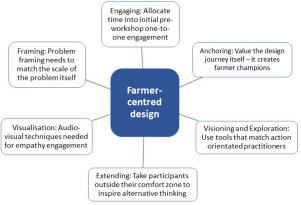Agricultural Systems ( IF 6.6 ) Pub Date : 2021-11-12 , DOI: 10.1016/j.agsy.2021.103314 C.R. Eastwood 1 , F.J. Turner 1 , A.J. Romera 1, 2

|
CONTEXT
Structured co-design processes are increasingly used for agricultural system redesign challenges. Many co-design processes were created in non-agricultural contexts, therefore there has been limited analysis of how they are best applied when involving farmers in co-design.
OBJECTIVE
The aims of this paper are to describe the application and affordances of co-design processes in a context of complex agricultural problems, and to build understanding on the use of such approaches with farmer stakeholders.
METHODS
We examine co-design affordances through two case studies: using Reflexive Interactive Design for future farm system redesign, and Design Thinking for farming workplace redesign. Data collection involved surveys and phone interviews of co-design participants, notes from project team observations and reflections, and direct farmer participant feedback. We critically evaluated the co-design processes using an affordances-based analytical framework.
RESULTS AND CONCLUSIONS
Co-design methods can enable researchers to engage with farmers and other agricultural stakeholders to address major agricultural redesign challenges. However, farmers are not always comfortable with highly analytical methods used in some co-design processes. Through the two case studies analysed in this paper, we propose the concept of farmer-centred design, where effective inclusion of farmers in design processes is achieved by selecting the co-design approaches used based on the affordances they provide farmer participants. Processes based on structural affordances (harnessing and aggregating) may frustrate farmer co-designers, while second-order functional affordances, such as exploration, visioning, and extending, can provide better alignment with farmer cognitive processes.
SIGNIFICANCE
This novel study describes the affordances of co-design tools and proposes an adapted framework for analysing affordances. The framework will benefit researchers when determining the co-design approach that matches their redesign challenge.
中文翻译:

以农民为中心的设计:一个基于可供性的框架,用于确定有助于农民作为共同设计者应对复杂农业挑战的过程
语境
结构化协同设计流程越来越多地用于应对农业系统重新设计挑战。许多协同设计过程是在非农业环境中创建的,因此对于农民参与协同设计时如何最好地应用它们的分析很有限。
客观的
本文的目的是描述在复杂农业问题背景下协同设计过程的应用和可供性,并与农民利益相关者建立对此类方法使用的理解。
方法
我们通过两个案例研究来检验协同设计的可供性:使用 Reflexive Interactive Design 进行未来农场系统的重新设计,以及使用 Design Thinking 进行农场工作场所的重新设计。数据收集包括对共同设计参与者的调查和电话采访、项目团队观察和反思的记录以及农民参与者的直接反馈。我们使用基于可供性的分析框架批判性地评估了协同设计过程。
结果和结论
共同设计方法可以使研究人员与农民和其他农业利益相关者接触,以应对重大的农业重新设计挑战。然而,农民并不总是对某些协同设计过程中使用的高度分析方法感到满意。通过本文分析的两个案例研究,我们提出了以农民为中心的设计概念,通过根据农民参与者提供的可供性选择使用的协同设计方法,可以有效地将农民纳入设计过程。基于结构可供性(利用和聚合)的过程可能会让农民的合作设计师感到沮丧,而二阶功能性可供性,如探索、愿景和扩展,可以更好地与农民的认知过程保持一致。
意义
这项新颖的研究描述了协同设计工具的可供性,并提出了一个适用于分析可供性的框架。在确定与重新设计挑战相匹配的协同设计方法时,该框架将使研究人员受益。

























 京公网安备 11010802027423号
京公网安备 11010802027423号